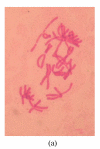Antimutagenic potential of curcumin on chromosomal aberrations in Allium cepa
- PMID: 17610326
- PMCID: PMC1906592
- DOI: 10.1631/jzus.2007.B0470
Antimutagenic potential of curcumin on chromosomal aberrations in Allium cepa
Abstract
Turmeric has long been used as a spice and food colouring agent in Asia. In the present investigation, the antimutagenic potential of curcumin was evaluated in Allium cepa root meristem cells. So far there is no report on the biological properties of curcumin in plant test systems. The root tip cells were treated with sodium azide at 200 and 300 microg/ml for 3 h and curcumin was given at 5, 10 and 20 microg/ml for 16 h, prior to sodium azide treatment. The tips were squashed after colchicine treatment and the cells were analyzed for chromosome aberration and mitotic index. Curcumin induces chromosomal aberration in Allium cepa root tip cells in an insignificant manner, when compared with untreated control. Sodium azide alone induces chromosomal aberrations significantly with increasing concentrations. The total number of aberrations was significantly reduced in root tip cells pretreated with curcumin. The study reveals that curcumin has antimutagenic potential against sodium azide induced chromosomal aberrations in Allium cepa root meristem cells. In addition, it showed mild cytotoxicity by reducing the percentage of mitotic index in all curcumin treated groups, but the mechanism of action remains unknown. The antimutagenic potential of curcumin is effective at 5 microg/ml in Allium cepa root meristem cells.
Figures







Similar articles
-
Evaluation of the antimutagenic activity and mode of action of the fructooligosaccharide inulin in the meristematic cells of Allium cepa culture.Genet Mol Res. 2014 Feb 14;13(3):4808-19. doi: 10.4238/2014.February.14.14. Genet Mol Res. 2014. PMID: 24615117
-
Anti-mutagenic potential of algal extracts on chromosomal aberrations in Allium cepa L.Acta Biol Hung. 2017 Jun;68(2):137-149. doi: 10.1556/018.68.2017.2.2. Acta Biol Hung. 2017. PMID: 28605976
-
Assessment of anticytotoxic effect of lichen Cladonia foliacae extract on Allium cepa root tips.Environ Sci Pollut Res Int. 2018 Nov;25(32):32478-32490. doi: 10.1007/s11356-018-3221-6. Epub 2018 Sep 20. Environ Sci Pollut Res Int. 2018. PMID: 30238257
-
Allium cepa test in environmental monitoring: a review on its application.Mutat Res. 2009 Jul-Aug;682(1):71-81. doi: 10.1016/j.mrrev.2009.06.002. Epub 2009 Jul 2. Mutat Res. 2009. PMID: 19577002 Review.
-
Allium cepa test vs. insecticides: a scientometric and meta-analytical review.Environ Sci Pollut Res Int. 2022 Jun;29(28):42678-42691. doi: 10.1007/s11356-021-15953-5. Epub 2022 Jan 28. Environ Sci Pollut Res Int. 2022. PMID: 35089509
Cited by
-
Soothing the Itch: The Role of Medicinal Plants in Alleviating Pruritus in Palliative Care.Plants (Basel). 2024 Dec 16;13(24):3515. doi: 10.3390/plants13243515. Plants (Basel). 2024. PMID: 39771213 Free PMC article. Review.
-
Standardization of bulb and root sample sizes for the Allium cepa test.Ecotoxicology. 2011 Jun;20(4):927-35. doi: 10.1007/s10646-011-0602-8. Epub 2011 Feb 5. Ecotoxicology. 2011. PMID: 21298340
-
Dendrosomal Curcumin Showed Cytotoxic Effects on Breast Cancer Cell Line by Inducing Mitochondrial Apoptosis Pathway and Cell Division Arrest.Iran J Pharm Res. 2024 Oct 13;23(1):e151714. doi: 10.5812/ijpr-151714. eCollection 2024 Jan-Dec. Iran J Pharm Res. 2024. PMID: 39830662 Free PMC article.
-
Protective effect of dietary curcumin in Anabas testudineus (Bloch) with a special note on DNA fragmentation assay on hepatocytes and micronucleus assay on erythrocytes in vivo.Fish Physiol Biochem. 2013 Oct;39(5):1323-30. doi: 10.1007/s10695-013-9786-6. Epub 2013 Mar 21. Fish Physiol Biochem. 2013. PMID: 23515757
-
Curcumin protects against nicotine-induced stress during protein malnutrition in female rat through immunomodulation with cellular amelioration.Mol Biol Rep. 2015 Dec;42(12):1623-37. doi: 10.1007/s11033-015-3929-z. Epub 2015 Nov 11. Mol Biol Rep. 2015. PMID: 26559197
References
-
- Adams BK, Ferstl EM, Davis MC, Herold M, Kurtkaya S, Camalier RF, Hollingshead MG, Kaur G, Sausville EA, Rickles FR, et al. Synthesis and biological evaluation of novel curcumin analogs as anti-cancer and anti-angiogenesis agents. Bioorg Med Chem. 2004;12(14):3871–3883. doi: 10.1016/j.bmc.2004.05.006. - DOI - PubMed
-
- Anto RJ, Mukhopadhyay A, Denning K, Aggarwal BB. Curcumin (diferuloylmethane) induces apoptosis through activation of caspase-8, BID cleavage and cytochrome c release: its suppression by ectopic expression of Bcl-2 and Bcl-xl. Carcinogenesis. 2002;23(1):143–150. doi: 10.1093/carcin/23.1.143. - DOI - PubMed
-
- Antunes LM, Araujo MC, Darin JD, Bianchi ML. Effects of the anti-oxidants curcumin and vitamin C on cisplatin induced clastogenesis in Wistar rat bone marrow cells. Mutat Res. 2000;465(1-2):131–137. - PubMed
Publication types
MeSH terms
Substances
LinkOut - more resources
Full Text Sources
Other Literature Sources

